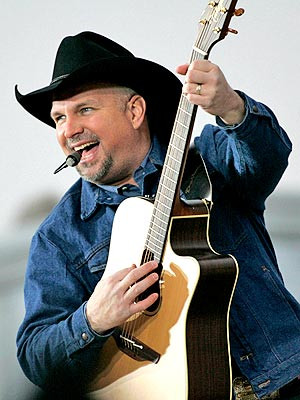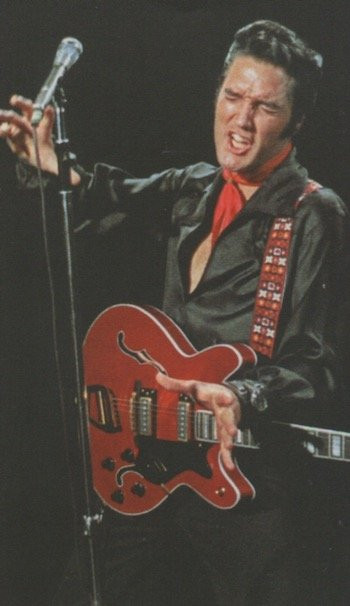Garth Brooks might not be the first name that springs to mind when you think of Elvis Presley, but bear with me. Back in 2007, a Vancouver DJ, Red Robinson, drew a surprising comparison: Garth Brooks, he claimed, ignited concert crowds with a fervor akin to Elvis in his 1957 Vancouver performance. Skeptical? Perhaps. But consider this: when Garth Brooks announced a Spokane, Washington concert in 2017, 84,000 tickets vanished online in a mere 90 minutes. Seven sold-out shows later, it was clear Brooks possessed a Presley-esque power to captivate.
 Garth Brooks performing on stage, demonstrating his captivating stage presence and connection with the audience, which some compare to the energy of Elvis Presley concerts.
Garth Brooks performing on stage, demonstrating his captivating stage presence and connection with the audience, which some compare to the energy of Elvis Presley concerts.
Now, while this is an Elvis blog, a detour through Garth Brooks territory isn’t as random as it seems. Amongst the few country songs in my iTunes library is Brooks’ “The Dance,” often hailed as his signature song. The ballad’s poignant lyrics, penned by Tony Arata, resonate in a way that unexpectedly mirrors the long and winding relationship between Elvis and his devoted fans. Let’s look at some key lines:
“Looking back on the memory of the dance we shared ’neath the stars above,
For a moment all the world was right.
How could I have known that you’d ever say goodbye.”
“And now I’m glad I didn’t know the way it all would end, the way it all would go.
Our lives are better left to chance.
I could have missed the pain, but I’d have had to miss the dance.”
Thinking of these lyrics in the context of Elvis fandom might seem like a leap, but consider them metaphorically. It’s not a literal love song to fans, but a figurative reflection on the changing tides of adoration and the enduring power of shared moments.
The Evolving Eras of Elvis Fans: A Dance Through Time
Elvis’s fanbase wasn’t a static entity; it was a dynamic wave that ebbed and flowed through distinct periods. Imagine each era as a different “dance” with Elvis, a unique experience of connection at various points in his career.
The first dance began in the mid-1950s. As Elvis’s raw, revolutionary sound rippled through the American South, early adopters in smaller towns caught his electrifying performances and radio broadcasts. Then came the explosion of 1956-57. Elvis stormed the national stage, conquering over 100 cities with live shows, gracing neighborhood cinemas with his first films, and invading living rooms through a dozen television appearances. This era saw a massive influx of fans, captivated by his youthful rebellion and groundbreaking music.
The third wave of fans arrived as Elvis emerged from his army service in 1960. This was a more mature, polished Elvis, transitioning from rockabilly rebel to pop crooner and movie idol. He charmed a new audience, different from the screaming teenagers of the 50s. Then came the Vegas era of the 1970s, marked by spectacular stage shows and nationwide tours. This period drew in yet another set of fans, many of whom were perhaps rekindling an earlier admiration or discovering Elvis anew as adults. Finally, even after his passing in 1977, a continuous stream of new fans has found Elvis, drawn to his timeless music and enduring legend.
 Elvis Presley during his ’68 Comeback Special, showcasing his return to raw rock and roll energy and captivating a new generation of fans while rekindling the passion of older ones.
Elvis Presley during his ’68 Comeback Special, showcasing his return to raw rock and roll energy and captivating a new generation of fans while rekindling the passion of older ones.
While many initial fans remained loyal throughout these transformations, Elvis inevitably lost some followers as his music and image evolved. His two-year army service starting in 1958 was a significant turning point. He vanished from the public eye, leaving a void. His primary fanbase at the time, teenagers around 14-15, were particularly susceptible to change. Two years is an eternity in adolescence, and new idols like Ricky Nelson and Frankie Avalon emerged. For these fans, Elvis’s departure must have felt like a goodbye, a bittersweet end to their first “dance” with the King. Yet, the initial thrill of that connection, that first spark of fandom, likely remained a cherished memory.
From Movie Screens to Concert Stages: My Own “Dance” with Elvis
I myself belong to the third wave, the post-army fans who discovered Elvis in his early sixties pop-movie star phase. In 1962, at the age of 13, “Return to Sender” topped the charts, and Girls! Girls! Girls! lit up cinema screens. This was my Elvis. We, the early 60s fans, knew him primarily from film and records, with little hope of seeing him live in concert. However, even within this era, Elvis faced new challenges. The arrival of The Beatles in 1964 shifted the musical landscape dramatically. For some fans, including my own brother, Elvis’s continued focus on Hollywood felt like a relinquishing of his rock and roll crown.
While my loyalty to Elvis remained, a sense of disappointment crept in as he continued down the path of formulaic movies and less groundbreaking music. Yet, the profound impact of my initial “dance” with Elvis in 1962 was too deep to sever. I followed him through the artistically leaner years of the mid-to-late sixties, a period when many fans understandably drifted away, perhaps with a sense of regret for what once was.
But Elvis, ever the showman, orchestrated another comeback. His 1970s return to live performances marked the beginning of a fourth fan era. These were largely adult audiences now, as Elvis in his thirties, no longer held the same sway over teenage hearts. Yet, Vegas showrooms and arenas across the country filled with eager crowds. Many were undoubtedly older fans, reigniting their youthful passion. But there were also new faces, drawn to the зрелый and charismatic performer Elvis had become.
Facing Imperfection, Cherishing the Dance
Tragically, this fourth dance ended in heartbreak. Elvis’s self-destructive path led to his untimely death at 42. The initial shock gave way to sadness, then disappointment, and even a flicker of anger as the carefully constructed image of a flawless icon crumbled, revealing a flawed human being beneath. Coming to terms with Elvis’s imperfections was a process. Yet, his undeniable talent and the sheer joy his music brought remained undeniable. The memory of that initial “epiphany” in 1962, my personal “dance” with Elvis, was too powerful to erase. And so, like the lyrics of Garth Brooks’ song suggest, “I could have missed the pain, but I’d have had to miss the dance.” The journey of Elvis fandom, with all its peaks and valleys, was a dance worth taking, imperfections and all.
